Abstract
To utilize the high efficiency of gasoline direct injection (GDI) and solve the high particulate number (PN) issue, hydrogen-rich syngas has been adopted as a favorable sustainable fuel. This paper compares and analyzes the effects of the injection configurations (GDI, gasoline port injection combined with GDI (PGDI), and gasoline port injection combined with hydrogen-rich syngas direct injection (PSDI)) and fuel properties on combustion and emissions in a spark-ignition engine. The operational points were fixed at 1800 rpm with a 15% throttle position, and the excess air ratio was 1.1. The conclusions show that PSDI gained the highest maximum brake thermal efficiency (BTE) at the MBT point, and the maximum BTE for GDI was only 94% of that for PSDI. PSDI’s CoVIMEP decreased by 22% compared with GDI’s CoVIMEP. CO and HC emissions were reduced by approximately 78% and 60% from GDI to PSDI among all the spark timings, respectively, while PSDI emitted the highest NOX emissions. As for particulate emissions, PSDI emitted the highest nucleation-mode PN, while GDI emitted the lowest. However, the accumulation-mode PN emitted from PSDI was approximately 52% of that from PGDI and 5% of that from GDI. This study demonstrates the benefits of PSDI for sustainability in vehicle engineering.
1. Introduction
With the development of engine technologies, gasoline direct injection (GDI) and port fuel injection (PFI) have been widely used for modern spark-ignition engines. As direct fuel injection can be more accurately controlled both for quantity and timing, GDI generally provides better transient condition performance, which results in better fuel economy and lower CO2 emissions [1,2]. However, previous research has concluded that GDI emits more particulate emissions than PFI because the time for mixture forming is relatively short, and locally fuel-rich regions appear more [3,4].
It is important to recognize the connection between particulate emissions and sustainability as well as take steps to reduce emissions and promote sustainable practices due to their adverse impact on air quality, human health, and the environment [5]. Therefore, to make GDI engines conform to the sustainability of vehicle engineering, GDI combined with PFI seems to be a promising method to improve efficiency and simultaneously solve the emissions issue [6,7,8]. Kang et al. developed a single-cylinder, four-stroke engine that adopts one direct injection system combined with one port injector. The results showed that the engine load characteristics were widened compared with a conventional spark-ignition direct injection (SIDI) engine, and knock reduction and engine flexibility can also be found in a dual-fuel dual-injection engine [9]. Sun et al. investigated the particulate number (PN) reduction and size distribution in a combined dimethyl ether/gasoline injection SI engine. They concluded that by increasing the proportion of dimethyl ether direct injection, both the nucleation and accumulation modes of PN emissions drop remarkably [10].
On the other side, finding alternative fuels for internal combustion engines is also a feasible pathway for sustainable development to meet stringent emission regulations and solve the shortage of conventional fuel [11]. Synthesis gas (syngas) is considered an attractive substitute energy due to its abundant sources and clean combustion characteristics [12]. The feedstock for syngas can be biomass, coal, refinery coke, or even landfill waste, whilst the manufacturing methods include gasification, fuel reforming, and fermentation [13,14]. The combustible species of syngas are H2, CO, and CH4, and the inert diluents of syngas are mainly N2 and CO2. The high hydrogen content in syngas determines that syngas belongs to clean energy [15]. The production method affects the specific composition of syngas, for example, applying catalytic gasification technology to gasify biomass could yield a hydrogen-enriched synthetic gas with hydrogen and CO contents of up to 50% and 17% by volume [16]. Harun et al. reported that the CO contained in syngas could increase the knock limit, and the combustion duration was also prolonged [17]. Concerning hydrogen-rich syngas, the physicochemical characteristics of hydrogen can be inherited to some extent, while the sources of syngas are much more convenient than hydrogen [18,19]. Hydrogen has some excellent physicochemical characteristics, such as wide flammability, low minimum ignition energy, a high laminar burning velocity, and a small quenching distance [20]. Therefore, injecting syngas directly into a cylinder may have a better effect on reducing emissions than gasoline direct injection because of the fuel properties.
To figure out the environmental issues and sustainable development, the influences of syngas on gaseous emissions have been widely investigated [15]. Huang et al. studied how the ignition timing affects emissions from a syngas internal combustion engine containing hydrogen by using a spark plug reformer system [21]. They successfully developed a spark plug reformer system that can reduce power consumption and operate under a low operating temperature [22]. The experiment showed that when the spark timing was adjusted to the MBT, HC and NOX emissions decreased, while CO2 and CO emissions slightly increased with the use of syngas. Grzegorz et al. also concluded that hydrogen-rich syngas and high equivalence ratios cause a higher reaction temperature that favors NOX emissions [23]. Harun et al. compared the content ratio of hydrogen and CO in syngas and obtained that the emissions were greatly related to the syngas composition. In particular, the NO level with a H2/CO ratio of 2.36 was lower than that with a H2/CO ratio of 0.62 even though it had a high exit temperature and hydrogen content [24]. Similarly, Ouimette et al. reported a different NOX emission tendency of syngas in partially premixed combustion conditions. They indicated that NOX emissions remained stable for syngas mixtures with a H2/CO ratio of 0–1.3, whereas NOX emissions exhibited a clear downward trend with higher ratios (>1.3) [25].
There are few published papers that have studied the particulate matter (PM) in syngas combustion, but the effect of hydrogen on particulate emissions has been investigated. Singh A. P. et al. compared the PM emissions from hydrogen-, CNG-, HCNG-, gasoline-, and diesel-fueled engines. They reported that hydrogen emitted the lowest PN and the lowest amount of PM among the researched fuels. Moreover, hydrogen enrichment of CNG reduced the total PM emissions [26]. Zhao et al. analyzed PM emissions from a GDI engine using a hydrogen and gasoline mixture. The findings revealed that under a low load, blending 5% hydrogen into the stoichiometric mixture can lower the total PM mass and PM number by up to 90%, and a further reduction in the total mass to 95% as well as in the total number to 97% can be achieved with 10% hydrogen. Nevertheless, under a high load, although hydrogen addition decreased the number of smaller particles, it encouraged the generation of accumulation-mode particles [27].
Thus, in this study, to realize both high thermal efficiency and low engine emissions, the adoption of hydrogen-rich syngas direct injection in a combined fuel injection–SI engine was evaluated. Two sets of experiments were formulated. The first one was about the comparison between GDI and gasoline port injection combined with GDI (PGDI) and aimed to analyze the configuration characteristic of the combined injection system. The second set of experiments was about the comparison between PGDI and gasoline port injection combined with syngas direct injection (PSDI), aiming to further analyze the fuel properties of syngas. In addition, from our previous research, a comparison between the injection modes containing GDI, PGDI, and gasoline port injection combined with hydrogen direct injection was carried out, and the experiments showed that the combination of an injection mode with fuel had a great influence on engine behavior [28,29,30], which means this specific investigation on the combustion, gaseous emission, and PN emission characteristics of syngas, which have not been studied yet, is novel and will be useful to meet sustainable development requirements.
2. Materials and Methods
2.1. Experimental Setup
The prototype engine was an in-line four-cylinder water-cooled spark-ignition direct injection (SIDI) engine, which originally had two injection systems, one direct injection system, and one port injection system. The cylinder head was furnished with centrally mounted spark plugs and direct injectors situated between intake valves. Port injectors were arranged on intake manifolds. Table 1 lists the detailed specifications of the prototype engine. The injection timing and duration for both gasoline and syngas were controlled with a self-developed ECU that can also adjust the throttle position and ignition timing. The syngas used in this experiment was hydrogen-rich syngas with fixed 85% H2 and 15% CO by volume to eliminate interferences [31,32]. The specifications of the gasoline and syngas are shown in [28] and [33]. To maintain the operating state with a fixed excess air ratio (λ), the requested fuel distribution ratio was obtained through the precise monitoring of the airflow, syngas flow, and gasoline flow. Moreover, due to the wide flammability of hydrogen, a flame arrestor was installed within the hydrogen supply line to avoid backfire. Figure 1 illustrates the overall schematic layout of the experimental system.

Table 1.
Original engine specifications.
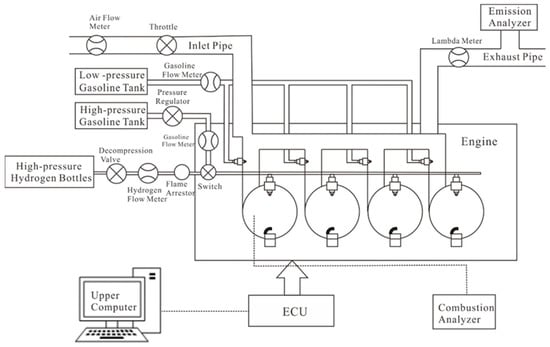
Figure 1.
Schematic layout of the experimental system.
During the experiments, the engine’s speed and torque were measured using an ECD CW160 that was controlled with an FST-OPEN system. A GU13Z-24 piezoelectric pressure sensor was used to measure the cylinder pressure, and the crank angle was measured with a Kistler-2614B4 encoder. Both sets of data were transmitted to a combustion analyzer to calculate the real-time cylinder pressure and analyze the combustion process through the combustion analysis software (DS 0928). The excess air ratio was recorded with a Meter LA4 lambda sensor, and a wideband oxygen transducer was mounted onto the exhaust pipe. The syngas mass flow was monitored with a DMF-1-1 AB gas flow meter. In addition, the regular gas emissions could be measured simultaneously with a DiCom 4000 analyzer. Particulate emissions were recorded using a DMS500, which can measure the particulate number and provide the PN size distribution. The specific information on the testing instruments including the measuring error is shown in Table 2.

Table 2.
Information on testing instruments.
2.2. Experimental Procedures
In all the experiments, the engine speed was constant at 1800 rpm, representing a normal urban situation. Some research studies have indicated that different injection modes could affect volumetric efficiency [34]. To highlight the influence of volumetric efficiency, a low engine load associated with a small throttle position was chosen. Therefore, the throttle position was fixed at 15% for all the experiments, and other loads will be investigated in future work. The port fuel injection was aimed to form a homogenous mixture, and the port injection time was set at 300 crank angle degrees before the top dead center (CAD BTDC). Both the syngas and gasoline direct injection pressures were set at 3 MPa to unify the standards. In previous studies, when hydrogen was injected at 100 CAD BTDC, the engine exhibited the best efficiency and the highest power output, so the direct injection timings in this study were set at 100 CAD BTDC (both for syngas and gasoline) [35]. As low-temperature combustion achieved via lean-burn has been proven to be beneficial for increasing engine efficiency and decreasing emissions [36,37], and syngas can extend the lean-burn limit, the experiments were conducted under lean-burn conditions. The λ was fixed at 1.1, and the definition of λ is shown as follows:
In Equation (1), represents the air volumetric flow rate, and represents the density of air. and denote the measured mass flow rates of syngas and gasoline. Especially for the PDI mode, equals the total gasoline mass flow rate including both direct injection and port injection. and are equal to 29.52 and 14.6 as the stoichiometric air–fuel ratios of syngas and gasoline, respectively.
The definition of the fuel distribution ratio is indicated in Equation (2) representing the energy ratio:
In Equation (2), denotes the fuel distribution ratio, and represent the heat released by the direct injection fuel (the gasoline direct injection portion in PGDI and that of syngas in PSDI) and port injection fuel, respectively. The heat is calculated from the mass flow rate and the low heating value (LHV). As the onboard syngas production amount was limited, the direct injection portion was regarded as an improver to fit the practical application [38]. Therefore, the for the PGDI mode was fixed at 20%, while the PSDI mode had a lower of 10%.
To find the effect on the combustion and emissions characteristics at various sparking timings, a range of spark timings from 10 CAD BTDC to 30 CAD BTDC were employed. The combustion parameters were measured and averaged in 200 continuous cycles at all test points. Concretely, the cylinder pressure, brake thermal efficiency (BTE), combustion durations (CA 0–10 and CA 10–90), indicated mean effective pressure (IMEP), and coefficient of variation in IMEP (CoVIMEP) were measured to analyze the combustion process. Moreover, the CO, HC, NOX, and PN emissions were recorded in the experiments to study the emission characteristics. Notably, the comparisons of the three injection modes are novel and will be useful for future vehicle engineering sustainability.
3. Results and Discussion
3.1. Cylinder Pressure and Brake Thermal Efficiency
Figure 2 and Figure 3 plot the in-cylinder pressure for the three kinds of injection modes with spark timings at 10 CAD BTDC and 25 CAD BTDC. The cylinder pressures for PSDI show the highest cylinder pressure, while GDI presents the lowest value in both figures. Firstly, investigating the injection configuration and then analyzing the fuel properties indicated some detailed effects among the three injection modes. Port fuel injection has more time to form a homogenous mixture beneficially, and the direct injection portion can achieve stable and reliable ignition, so the combustion efficiency and cylinder pressure can be increased with combined fuel injection. This conclusion is similar to that in [39], which mainly focuses on fuel consumption and half-load performance. Furthermore, as syngas has a high laminar flame speed that can enhance the constant volume combustion degree, and its small quenching distance also facilitates more complete combustion, the cylinder pressure of PSDI performs higher than that of PGDI.
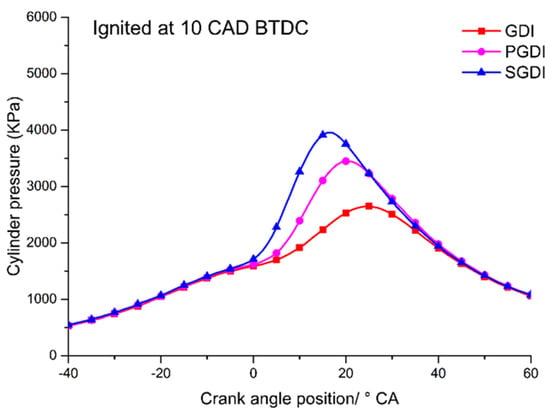
Figure 2.
In-cylinder pressure. Spark timing set at 10 CAD BTDC for 3 kinds of injection modes.
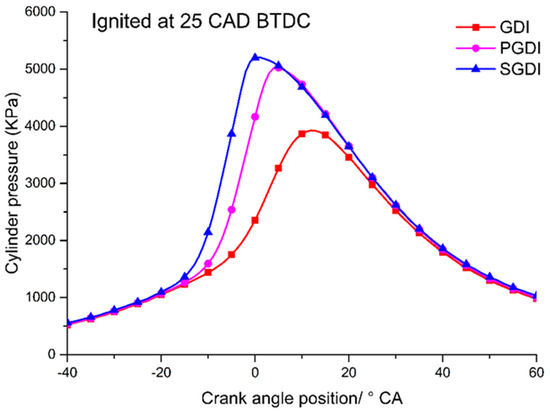
Figure 3.
In-cylinder pressure. Spark timing set at 25 CAD BTDC for 3 kinds of injection modes.
With 2 spark timings, the relevant crank angles for the maximum cylinder pressure of PSDI were only 16 CAD ATDC and 1 CAD ATDC, respectively. The relevant phasing was much more advanced than that of the GDI and PGDI modes, mainly because of the dramatically shortened combustion period. As syngas has a high laminar burning velocity, the combustion is more concentrated in the top dead center (TDC) with a specific spark timing. The cylinder pressure is an integrated result of the piston motion and combustion process, and the piston motion produces the highest pressure around the TDC (due to the smallest displacement). The concentrated combustion moves the highest cylinder pressure closer to the TDC, which enlarges the integrated pressure. Furthermore, advancing ignition lets more fuel burn before the TDC, and the accumulated heat before the TDC gradually increases, which results in higher in-cylinder pressure. However, the combustion deteriorates, as the relevant crank angle for the highest cylinder pressure is too early with an over-advanced spark timing.
Figure 4 plots the brake thermal efficiency (BTE) at various spark timings for three kinds of injection modes. As the minimum spark advance for best torque (MBT) for GDI and PGDI is 20 CAD BTDC, while the MBT for PSDI is only 10 CAD BTDC, the investigated ranges of ignition timings had a slight difference. When the spark timing was set at the MBT, PSDI demonstrated the highest maximum BTE (30.3%), while GDI showed the least maximum value (28.7%), and the maximum BTE of PGDI was 29.8%. The maximum BTE increased by 1.6% from GDI to PSDI. PGDI can form a more homogeneous mixture, producing complete combustion and higher BTE. As syngas has high diffusive efficiency and low ignition energy, the homogenous condition was further enhanced, and the requirement for combustion declined. These factors are all beneficial for complete combustion, which is critically beneficial for BTE. Moreover, a high laminar burning velocity shortens the combustion period and reduces heat transfer loss. As such, PSDI has higher BTE than GDI because of more complete combustion, higher combustion efficiency, and less heat transfer loss.
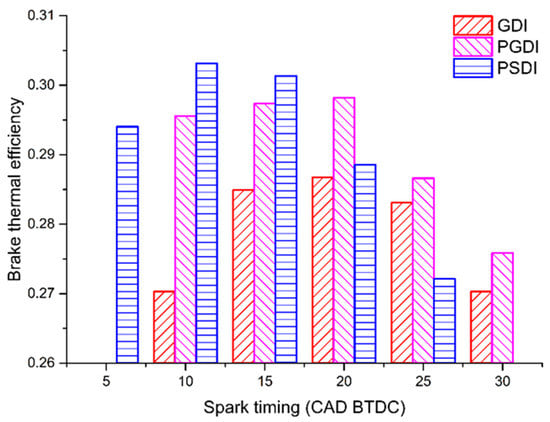
Figure 4.
BTE versus spark timings for three kinds of injection modes.
Figure 4 also shows that the BTE first rises and then descends with an advancing spark timing. This is because an over-advanced spark timing makes more fuel burn during the compression stroke which produces more negative compression work and decreases the BTE. Comparatively, over-retarding the spark timing would enlarge the extent of post-combustion, and more fuel would burn during the expansion stroke, resulting in lower BTE. It is worth noting that when the spark advance angle was larger than 15 CAD, the BTE of PSDI decreased quickly and was even worse than that of GDI. This is because the combustion duration for PSDI is relatively short, and over-advancing ignition causes most of the combustion to be completed before the TDC, and the negative compression work increases. Subsequently, the BTE for PSDI declined dramatically. As the combustion speeds are lower in GDI and PGDI, the influences by over-advancing ignition are relatively small for these two modes. Thus, PSDI is more sensitive to spark timings because of the high flame speed.
Figure 5 shows the cylinder temperature at the exhaust valve opening (TEVO) versus the spark timings for the three kinds of injection modes. The TEVO reflects the engine post-combustion and exhaust loss to some extent [40]. The cam phasing was fixed just as the original engine and the exhaust valve opened at 26 CAD before the bottom dead center (BBDC). The TEVOs for the GDI and PGDI modes are relatively similar, and the TEVO for the PSDI mode is substantially higher than those for the other modes. The exhaust temperature for PSDI shows the highest value because of the fast burning velocity and higher maximum cylinder pressure. The TEVO mainly affected the emissions characteristics, and the details will be discussed in Section 3.3.
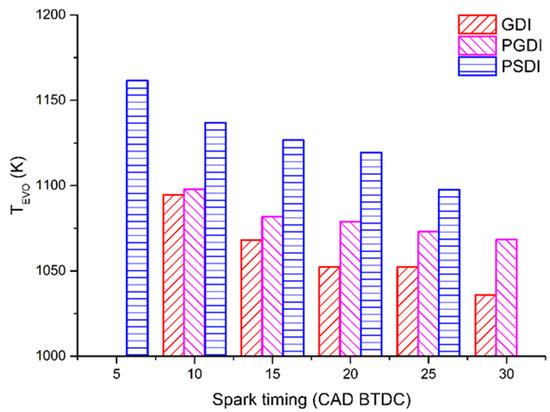
Figure 5.
TEVO versus spark timings for three kinds of injection modes.
3.2. Combustion Analysis
Figure 6 plots the flame development duration (0–10% mass fraction burned; CA 0–10) at various spark timings for the 3 kinds of injection modes, and Figure 7 plots the flame propagation duration (10%–90% mass fraction burned; CA 10–90). PGDI shows a shorter duration for both CA 0–10 and CA 10–90 than GDI, and PSDI demonstrates the shortest durations for both parts. The combined injection mode can form a more stratified mixture than the pure GDI mode, which eases the formation of the flame kernel and accelerate the whole combustion period, so PGDI indicates shorter combustion durations. According to previous studies, adding hydrogen to methane and ethanol stimulates the formation of O, OH, and H radicals, which are kinds of improvers for chain reactions [41,42]. The syngas used in this investigation was hydrogen-rich, so it inherited some hydrogen characteristics, and gasoline is a kind of hydrocarbon fuel that is chemically similar to ethanol and methane. Thus, the formation of radicals stimulated via syngas accelerates combustion and shortens the combustion period. A shorter CA 0–10 means more stable combustion, while a shorter CA 10–90 means the combustion process is closer to the constant volume process, allowing higher thermal efficiency [43]. Hence, it is further certified that PSDI has the most stable combustion and the highest thermal efficiency among the three injection modes. On the other hand, by advancing the ignition timing, CA 0–10 was prolonged while CA 10–90 was shortened for all three injection modes. Advancing ignition deteriorates the initial condition for forming the flame kernel, and CA 0–10 is prolonged. Retarding ignition expands the degree of post-combustion, and the combustion at this stage is mainly diffusion combustion with a low burning rate. Thus, the CA 10–90 duration is extended by retarding the ignition timing.
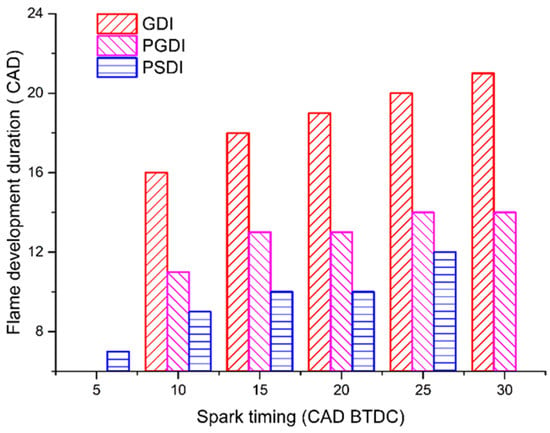
Figure 6.
CA 0–10 versus spark timings for three kinds of injection modes.
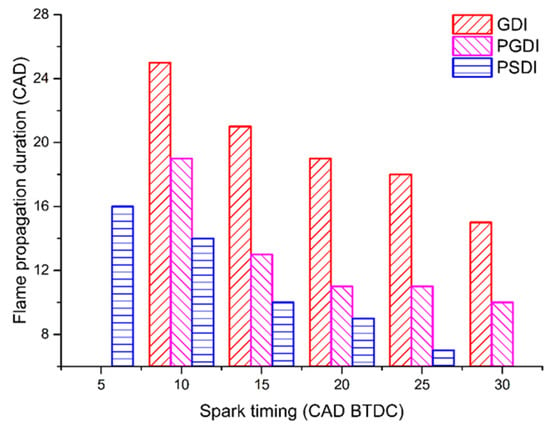
Figure 7.
CA 10–90 versus spark timings for three kinds of injection modes.
Figure 8 plots the coefficients of variation (CoVs) in the IMEP at various spark timings for the three kinds of injection modes. The CoVIMEP of GDI is dramatically higher than those of the other two modes, and it is very sensitive to spark timings. Specifically, the minimum CoVIMEP of PSDI decreases by 22% from the minimum CoVIMEP of GDI. Many investigations have indicated that a short combustion duration helps to ease an engine’s cyclic variations [44]. It is seen in Figure 6 and Figure 7 that the combustion duration of GDI is obviously long, leading to a high CoVIMEP. Figure 8 also indicates that the CoVIMEP reaches its lowest value at around the MBT point.
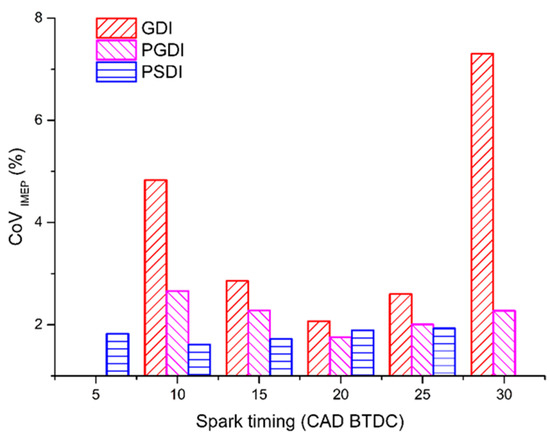
Figure 8.
CoVIMEP versus spark timings for three kinds of injection modes.
3.3. Gaseous Emissions and PN Emissions
Figure 9 plots CO emission at various spark timings for the three kinds of injection modes. GDI emits the highest CO emission, while PSDI emits the least. CO emissions were reduced by approximately 78% from GDI to PSDI among the whole range of spark timings. However, a 15% volumetric fraction of the syngas used in this experiment was CO, and the CO emission still shows the least value for PSDI, which further certifies that PSDI is beneficial for complete combustion and shows better stability. Ji C. et al. concluded that adjusting the spark timing has no clear effect on the CO emission of a hybrid hydrogen–gasoline engine [45], which agrees with the PSDI profile. CO emission decreased by retarding ignition for the GDI and PGDI modes, as the prolonged post-combustion induced by retarding ignition enhances the oxidation of CO.
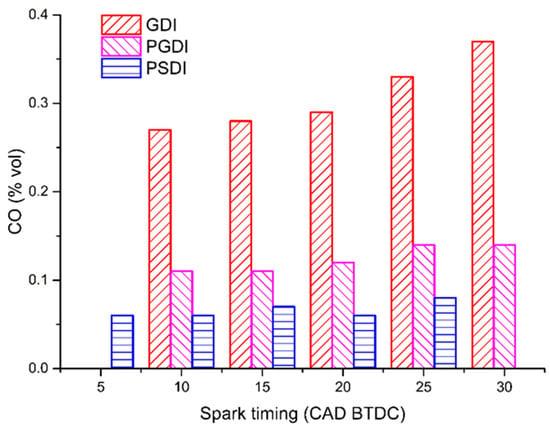
Figure 9.
CO emissions versus spark timings for three kinds of injection modes.
As is shown in Figure 10, GDI emits the highest HC emission, and PGDI and PSDI only emit small amounts. HC emissions were reduced by approximately 60% from GDI to PSDI with a 20 CAD BTDC spark timing. This is because the combined injection mode improves combustion completeness, which reduces the sources of HCs. For the GDI mode, HC emission decreased by retarding ignition, the reason for which could be ascribed to the enhanced oxidizing process caused by prolonged post-combustion and increased TEVO.
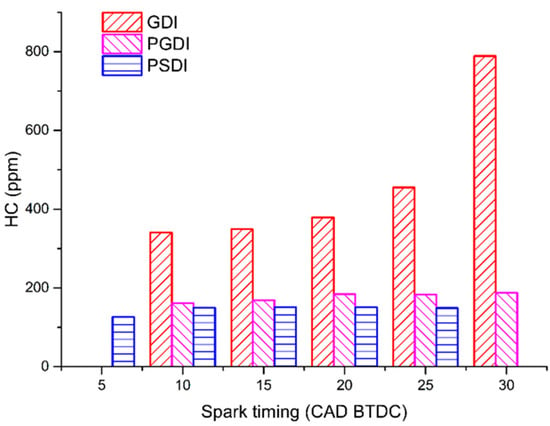
Figure 10.
HC emissions versus spark timings for three kinds of injection modes.
Figure 11 plots the NOX emissions at various spark timings for the three kinds of injection modes. PSDI produced the highest NOX emission, whereas GDI produced the lowest NOX emission. Specifically, the NOX emission from GDI was 44% and 32% of that of PGDI and PSDI, respectively. The main factors affecting NOX emissions include the oxygen fraction, cylinder temperature, and reserved time for high-temperature reactions [46]. As the data in Figure 11 show, PSDI still has a high NOX emission problem. However, as syngas direct injection avails stable combustion, lean-burn combustion and exhaust gas recirculation (EGR) technologies could be used to reduce NOX emissions without causing much damage to the engine performance according to [47]. Figure 11 also indicates that retarding ignition linearly reduces NOX emissions. This is because retarding ignition decreases the maximum cylinder temperature, which is a critical factor for NOX emission.
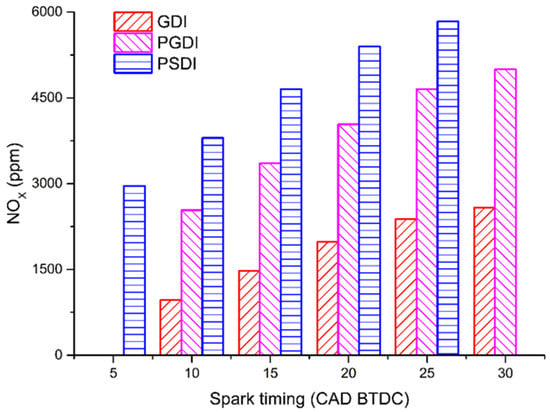
Figure 11.
NOX emissions versus spark timings for three kinds of injection modes.
Particulate emissions are a common issue for SIDI engines, and SIDI engines always have high particulate numbers relative to diesel engines, so the particulate emission numbers will be focused on herein. Figure 12 plots the total nucleation-mode PNs at various spark timings for the three kinds of injection modes, and Figure 13 shows the total accumulation-mode PNs for the three kinds of injection modes. Particles in nucleation mode are typically composed of volatile organic and sulfur compounds that form during exhaust dilution and cooling. Meanwhile, particles in accumulation mode are mainly made up of carbonaceous agglomerates and associated adsorbed materials [48,49,50].
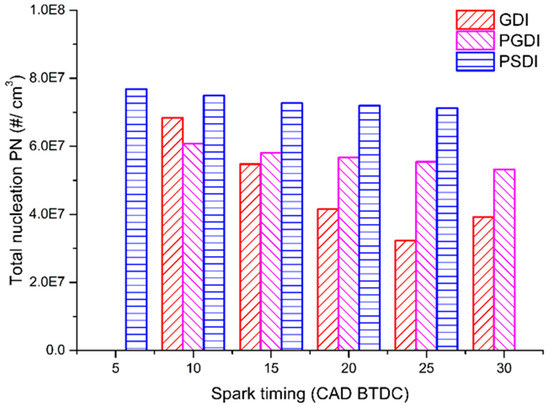
Figure 12.
Total nucleation-mode PNs versus spark timings for three kinds of injection modes.
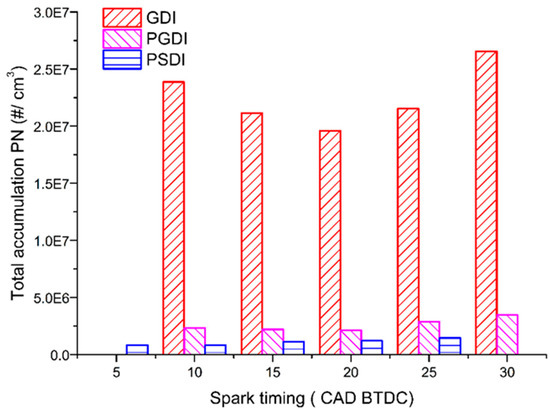
Figure 13.
Total accumulation-mode PNs versus spark timings for three kinds of injection modes.
Regarding the nucleation-mode PN, PSDI generally emits the highest value while GDI emits the lowest value. The nucleation-mode PN for GDI is only 45% of that for PSDI at a 20 CAD BTDC spark timing. As nucleation-mode particles are mainly from exhaust dilution and cooling, a higher exhaust temperature will enhance the nucleation process and result in more nucleation-mode particles. From the results shown in Figure 5, the TEVO of PSDI is the highest among the three injection modes, which is conducive to the formation of nucleation-mode particles. The three injection modes present different ignition characteristics in Figure 12, and GDI emits the lowest nucleation-mode PN at the MBT point, while PGDI and PSDI show slight variations with the spark timings. This is ascribed to the relatively high exhaust temperature and low unburned hydrocarbons in PSDI and PGDI, which decrease the propensity to oxidize the particles. Consequently, the PGDI and PSDI modes respond less sensitively to spark timings. Although PSDI increases the nucleation-mode PN, improving the dilution condition in the exhaust pipe and eliminating temperature differences will dramatically reduce the nucleation-mode PN.
Regarding the accumulation-mode PN, GDI shows the highest value, and PSDI indicates the lowest value. The accumulation-mode PN of PSDI is approximately 52% of PGDI’s and 5% of GDI’s, respectively. Accumulation particles are mainly formed during the combustion process of an inhomogeneous mixture [51]. PGDI dramatically enhances the homogenous situation in a cylinder via the port fuel injection, and the accumulation particle number obviously decreases from that of GDI. Particle growth and augmentation are mainly enacted through H atom loss and continue through the addition of the acetylene (HACA) mechanism [52]. Adding syngas increases the H atom amount in the cylinder, and the HACA mechanism is suppressed. Therefore, PSDI further reduces the accumulation-mode PN compared with PGDI.
4. Conclusions
This paper experimentally investigated the effect of hydrogen-rich syngas direct injection on combustion and emissions in a combined fuel injection—spark-ignition engine. Direct comparisons between the GDI, PGDI, and PSDI modes with cylinder pressure, BTE, CA0–10, CA10–90, CoVIMEP, CO, HC, NOX, and PN emissions versus spark timing were performed to analyze the effects of the injection configurations and the fuel properties to meet the requirements of sustainable development. The main conclusions are listed as follows:
- When the spark timing was fixed at the MBT for the three injection modes, PSDI gained the highest maximum BTE, while the maximum BTE of GDI was only 94% of PSDI’s. In addition, the BTE of PSDI was much more sensitive than that of the other two modes due to the high burning rate of syngas.
- PSDI performed the shortest durations, and GDI showed the longest duration for both CA0–10 and CA 10–90. The CoVIMEP of GDI was dramatically higher than that of the other two modes, and the variations were very sensitive to spark timings in GDI. The minimum CoVIMEP of PSDI decreased by 22% from the minimum value of GDI.
- CO emissions were reduced by approximately 78% from GDI to PSDI among the whole range of spark timings, and HC emissions were reduced by approximately 60% from GDI to PSDI. However, PSDI showed the highest NOX emissions, and GDI showed the lowest value. Specifically, the NOX emissions from GDI were 44% and 32% of that from PGDI and PSDI, respectively. Retarding ignition linearly reduced NOX emissions for the three injection modes.
- PSDI generally emitted the highest nucleation PN while GDI emitted the lowest. The nucleation-mode PN for GDI was only 45% of that for PSDI at a 20 CAD BTDC spark timing. Improving the exhaust conditions and eliminating temperature differences will dramatically reduce the nucleation-mode PN.
- GDI showed the highest accumulation-mode PN and PSDI indicated the lowest. The accumulation-mode PN for PSDI was approximately 52% of that for PGDI and only 5% of that for GDI. The small amount of accumulation-mode particles certifies the effect of hydrogen-rich syngas on reducing particles. Thus, PSDI is a feasible method to solve the high particulate emission issue in DISI engines and also improve engine performance.
In conclusion, the method of PSDI can exhibit the dual advantages of combined injection and syngas fuel properties to achieve high BTE and low CO, HC, and particulate emissions. In future research, we may develop a special exhaust after-treatment system for syngas or investigate the performance of syngas direct injection engines under various load conditions so as to better adapt to the sustainable development goal of vehicles.
Author Contributions
Conceptualization, Y.S. and X.Y.; validation, L.H.; formal analysis, Y.S.; investigation, Z.S. and Y.S.; resources, X.Y.; data curation, Z.S. and Y.S.; writing—original draft preparation, Y.S.; writing—review and editing, Z.S.; supervision, X.Y.; project administration, L.R.; funding acquisition, L.R. All authors have read and agreed to the published version of the manuscript.
Funding
This research was funded by the National Natural Science Foundation of China (NSFC, 62103160), the Jilin Province Science and Technology Development Plan Project (no. 20210508058RQ), and the Dingxin Scholar Support Program of Jilin University (no. BD0097).
Institutional Review Board Statement
Not applicable.
Informed Consent Statement
Not applicable.
Data Availability Statement
The data presented in this study are available on request from the corresponding author. The data are not publicly available due to privacy restrictions.
Conflicts of Interest
The authors declare no conflict of interest.
Abbreviations
SI, spark ignition; GDI, gasoline direct injection; PGDI, gasoline port injection combined with GDI; PSDI, gasoline port injection combined with hydrogen-rich syngas direct injection; λ, excess air ratio; Φ_D, fuel distribution ratio; BTE, brake thermal efficiency; CA 0–10, flame development duration; CA 10–90, flame propagation duration; IMEP, indicated mean effective pressure; CoVIMEP, coefficient of variation in IMEP; TEVO, cylinder temperature at exhaust valve opening; MBT, minimum spark advance for best torque; TDC, top dead center; BDC, bottom dead center; PN, particulate number; PM, particulate matter.
References
- Mon Oo, H.; Karin, P.; Charoenphonphanich, C.; Chollacoop, N.; Hanamura, K. Physicochemical characterization of direct injection Engines’s soot using TEM, EDS, X-ray diffraction and TGA. J. Energy Inst. 2021, 96, 181–191. [Google Scholar]
- Bao, J.; Qu, P.; Wang, H.; Zhou, C.; Zhang, L.; Shi, C. Implementation of various bowl designs in an HPDI natural gas engine focused on performance and pollutant emissions. Chemosphere 2022, 303, 135275. [Google Scholar] [CrossRef] [PubMed]
- Wang, X.; Chen, W.; Huang, Y.; Wang, L.; Zhao, Y.; Gao, J. Advances in soot particles from gasoline direct injection engines: A focus on physical and chemical characterization. Chemosphere 2023, 311, 137181. [Google Scholar] [CrossRef] [PubMed]
- Catapano, F.; Di Iorio, S.; Magno, A.; Vaglieco, B.M. Effect of fuel quality on combustion evolution and particle emissions from PFI and GDI engines fueled with gasoline, ethanol and blend, with focus on 10–23 nm particles. Energy 2022, 239, 122198. [Google Scholar] [CrossRef]
- Akasha, H.; Ghaffarpasand, O.; Pope, F. Climate change, air pollution and the associated burden of disease in the Arabian peninsula and neighbouring regions: A critical review of the literature. Sustainability 2023, 15, 3766. [Google Scholar] [CrossRef]
- Huang, Y.; Hong, G.; Huang, R. Effect of injection timing on mixture formation and combustion in an ethanol direct injection plus gasoline port injection (EDI + GPI) engine. Energy 2016, 111, 92–103. [Google Scholar] [CrossRef]
- Melaika, M.; Herbillon, G.; Dahlander, P. Spark ignition engine performance, standard emissions and particulates using GDI, PFI-CNG and DI-CNG systems. Fuel 2021, 293, 120454. [Google Scholar] [CrossRef]
- Yin, X.; Xu, L.; Duan, H.; Wang, Y.; Wang, X.; Zeng, K.; Wang, Y. In-depth comparison of methanol port and direct injection strategies in a methanol/diesel dual fuel engine. Fuel Process. Technol. 2023, 241, 107607. [Google Scholar] [CrossRef]
- Purayil, S.T.P.; Hamdan, M.O.; Al-Omari, S.A.B.; Selim, M.Y.E.; Elnajjar, E. Review of hydrogen–gasoline SI dual fuel engines: Engine performance and emission. Energy Rep. 2023, 9, 4547–4573. [Google Scholar] [CrossRef]
- Sun, P.; Feng, J.; Yang, S.; Wang, C.; Cui, K.; Dong, W.; Du, Y.; Yu, X.; Zhou, J. Particulate number and size distribution of dimethyl ether/gasoline combined injection spark ignition engines at medium engine speed and load. Fuel 2022, 313, 122645. [Google Scholar] [CrossRef]
- Zhang, B.; Wang, H.; Wang, S. Computational investigation of combustion, performance, and emissions of a diesel-hydrogen dual-fuel engine. Sustainability 2023, 15, 3610. [Google Scholar] [CrossRef]
- Ghulamullah, M.; Imran, A.; Kashif, H.M.; Safdar, A.; Hubdar, A.M.; Imran, N.U.; Abdul, M.P. Thermochemical conversion of biomass for syngas production: Current status and future trends. Sustainability 2022, 14, 2596. [Google Scholar]
- Kravos, A.; Seljak, T.; Opresnik, S.; Katrasnik, T. Operational stability of a spark ignition engine fuelled by low H2 content synthesis gas: Thermodynamic analysis of combustion and pollutants formation. Fuel 2020, 261, 116457. [Google Scholar] [CrossRef]
- Tartakovsky, L.; Sheintuch, M. Fuel reforming in internal combustion engines. Prog. Energy Combust. Sci. 2018, 67, 88–114. [Google Scholar] [CrossRef]
- Paykani, A.; Chehrmonavari, H.; Tsolakis, A.; Alger, T.; Northrop, W.F.; Reitz, R.D. Synthesis gas as a fuel for internal combustion engines in transportation. Prog. Energy Combust. Sci. 2022, 90, 100995. [Google Scholar] [CrossRef]
- Ji, M.; Wang, J. Review and comparison of various hydrogen production methods based on costs and life cycle impact assessment indicators. Int. J. Hydrog. Energy 2021, 46, 38612–38635. [Google Scholar] [CrossRef]
- Harun, Y.; Ilker, Y. Combustion and emission characteristics of premixed CNG/H2/CO/CO2 blending synthetic gas flames in a combustor with variable geometric swirl number. Energy 2019, 172, 117–133. [Google Scholar]
- Praveen, K.G.; Amit, K.S.; Arun, J.; Gopinath, K.P. Hydrogen-rich syngas production from the lignocellulosic biomass by catalytic gasification: A state of art review on advance technologies, economic challenges, and future prospectus. Fuel 2023, 342, 127800. [Google Scholar]
- Matamba, T.; Lglauer, S.; Keshavarz, A. A progress insight of the formation of hydrogen rich syngas from coal gasification. J. Energy Inst. 2022, 105, 81–102. [Google Scholar] [CrossRef]
- Alexandru, C.; Constantin, P.; Niculae, N.; Gheorghe, L.; Cristian, N.; Dinu, F. Hydrogen—An alternative fuel for automotive diesel engines used in transportation. Sustainability 2020, 12, 9321. [Google Scholar]
- Huang, D.; Jang, J.; Lin, P.; Chen, B. Effect of ignition timing on the emission of internal combustion engine with syngas containing hydrogen using a spark plug reformer system. Energy Procedia 2017, 105, 1570–1575. [Google Scholar] [CrossRef]
- Huang, D.; Lin, B.; Jang, J. Emission of internal combustion with low temperature plasma reformer. Energy Procedia 2015, 75, 3036–3041. [Google Scholar] [CrossRef]
- Grzegorz, P.; Willian, C.N. Emissions and efficiency of pure CO and H2-rich simulated gases combustion with peach and rice biomasses syngas characteristics: A renewable energy pathway for the agroindustrial sector in Rio Grande do Sul, Brazil. Energy Convers. Manag. 2023, 282, 116375. [Google Scholar]
- Harun, Y.; Omer, C.; Ilker, Y. A comparison study on combustion and emission characteristics of actual synthetic gas mixtures. Fuel 2020, 263, 116712. [Google Scholar]
- Ouimette, P.; Seers, P. NOx emission characteristics of partially premixed laminar flames of H2/CO/CO2 mixtures. Int. J. Hydrog. Energy 2009, 34, 9603–9610. [Google Scholar] [CrossRef]
- Singh, A.P.; Pal, A.; Agarwal, A.K. Comparative particulate characteristics of hydrogen, CNG, HCNG, gasoline and diesel fueled engines. Fuel 2016, 185, 491–499. [Google Scholar] [CrossRef]
- Zhao, H.; Stone, R.; Zhou, L. Analysis of the particulate emissions and combustion performance of a direct injection spark ignition engine using hydrogen and gasoline mixtures. Int. J. Hydrog. Energy 2010, 35, 4676–4686. [Google Scholar] [CrossRef]
- Shang, Z.; Yu, X.; Ren, L. Comparative study on effects of injection mode on combustion and emission characteristics of a combined injection n-butanol/gasoline SI engine with hydrogen direct injection. Energy 2020, 213, 118903. [Google Scholar] [CrossRef]
- Sun, Y.; Yu, X.; Jiang, L. Effects of direct hydrogen injection on particle number emissions from a lean burn gasoline engine. Int. J. Hydrog. Energy 2016, 41, 18631–18640. [Google Scholar] [CrossRef]
- He, F.; Li, S.; Yu, X. Comparison study and synthetic evaluation of combined injection in a spark ignition engine with hydrogen-blended at lean burn condition. Energy 2018, 157, 1053–1062. [Google Scholar] [CrossRef]
- Zhang, G.; Li, G.; Li, H.; Lv, J. Effect of diluent gas on propagation and explosion characteristics of hydrogen-rich syngas laminar premixed flame. Energy 2022, 246, 123370. [Google Scholar] [CrossRef]
- Kim, S.; Kim, J. Feasibility assessment of hydrogen-rich syngas spark-ignition engine for heavy-duty long-distance vehicle application. Energy Convers. Manag. 2022, 252, 115048. [Google Scholar] [CrossRef]
- Chacartegui, R.; Sanchez, D.; Escalona, J.M.; Sanchez, A.M.T. Gas and steam combined cycles for low calorific syngas fuels utilisation. Appl. Energy 2013, 101, 81–92. [Google Scholar] [CrossRef]
- Zareei, J.; Ghadamkheir, K.; Farkhondeh, S.; Abed, A.M.; Opulencia, M.; Alvarez, J. Numerical investigation of hydrogen enriched natural gas effects on different characteristics of a SI engine with modified injection mechanism from port to direct injection. Energy 2022, 255, 124445. [Google Scholar] [CrossRef]
- Yu, X.; Du, Y.; Sun, P.; Liu, L.; Wu, H.; Zuo, X. Effects of hydrogen direct injection strategy on characteristics of lean-burn hydrogen–gasoline engines. Fuel 2017, 208, 602–611. [Google Scholar] [CrossRef]
- Hong, B.; Lius, A.; Mahendar, S.; Mihaescu, M.; Cronhjort, A. Energy and exergy characteristics of an ethanol-fueled heavy-duty SI engine at high-load operation using lean-burn combustion. Appl. Therm. Eng. 2023, 224, 120063. [Google Scholar] [CrossRef]
- Chaurasiya, R.; Krishnasamy, A. A single fuel port and direct injected low temperature combustion strategy to reduce regulated pollutants from a light-duty diesel engine. Fuel 2023, 335, 127114. [Google Scholar] [CrossRef]
- Shi, C.; Chai, S.; Di, L.M.; Ji, C.; Ge, Y.; Wang, H. Combined experimental-numerical analysis of hydrogen as a combustion enhancer applied to Wankel engine. Energy 2023, 263, 125896. [Google Scholar] [CrossRef]
- Gong, C.; Yu, J.; Liu, F. Combined impact of excess air ratio and injection strategy on performances of a spark-ignition port- plus direct-injection dual-injection gasoline engine at half load. Fuel 2023, 340, 127605. [Google Scholar] [CrossRef]
- Zhang, B.; Ji, C.; Wang, S. Combustion analysis and emissions characteristics of a hydrogen-blended methanol engine at various spark timings. Int. J. Hydrog. Energy 2015, 40, 4707–4716. [Google Scholar] [CrossRef]
- Atelge, M.R. Experimental study of a blend of Diesel/Ethanol/n-Butanol with hydrogen additive on combustion and emission and exegetic. Fuel 2022, 325, 124903. [Google Scholar] [CrossRef]
- Liu, X.; Zhao, M.; Feng, M.; Zhu, Y. Study on mechanisms of methane/hydrogen blended combustion using reactive molecular dynamics simulation. Int. J. Hydrog. Energy 2023, 48, 1625–1635. [Google Scholar] [CrossRef]
- Li, J.; Zhang, R.; Pan, J.; Wei, H.; Shu, G.; Chen, L. Ammonia and hydrogen blending effects on combustion stabilities in optical SI engines. Energy Convers. Manag. 2023, 280, 116827. [Google Scholar] [CrossRef]
- Duan, X.; Deng, B.; Liu, Y.; Zou, S.; Liu, J.; Feng, R. An experimental study the impact of the hydrogen enrichment on cycle-to-cycle variations of the large bore and lean burn natural gas spark-ignition engine. Fuel 2020, 282, 118868. [Google Scholar] [CrossRef]
- Ji, C.; Wang, S.; Zhang, B. Effect of spark timing on the performance of a hybrid hydrogen-gasoline engine at lean conditions. Int. J. Hydrog. Energy 2010, 35, 2203–2212. [Google Scholar] [CrossRef]
- Sun, S.; Xu, D.; Liang, Y.; Jiang, G.; Diao, Y.; Gong, X.; Wang, B. Effect of temperature, oxygen concentration, and CaO addition on SO2 and NOx emissions during oxygen-fuel combustion of municipal sludge. J. Energy Inst. 2022, 105, 424–432. [Google Scholar] [CrossRef]
- Zhao, L.; Su, X.; Wang, X. Comparative study of exhaust gas recirculation (EGR) and hydrogen-enriched EGR employed in a SI engine fueled by biobutanol-gasoline. Fuel 2020, 268, 117194. [Google Scholar] [CrossRef]
- Wang, C.; Pei, Y.; Peng, Z.; Li, X. Insights into the effects of direct injection timing on the characteristics of deposited fuel film and Particulate Matter (PM) emissions from a Dual-Fuel Spark Ignition (DFSI) engine. Fuel Process. Technol. 2022, 238, 107515. [Google Scholar] [CrossRef]
- Thawko, A.; Tartakovsky, L. The mechanism of particle formation in non-premixed hydrogen combustion in a direct-injection internal combustion engine. Fuel 2022, 327, 125187. [Google Scholar] [CrossRef]
- Kurien, C.; Srivastava, A.K.; Lesbats, S. Experimental and computational study on the microwave energy based regeneration in diesel particulate filter for exhaust emission control. J. Energy Inst. 2020, 93, 2133–2147. [Google Scholar] [CrossRef]
- Su, Y.; Zhang, Y.; Xie, F.; Duan, J.; Li, X.; Liu, Y. Influence of ethanol blending ratios on in-cylinder soot processes and particulate matter emissions in an optical direct injection spark ignition engine. Fuel 2022, 308, 121944. [Google Scholar] [CrossRef]
- Anna, A.D.; Sirignano, M.; Kent, J. A model of particle nucleation in premixed ethylene flames. Combust. Flame 2010, 157, 2106–2115. [Google Scholar]
Disclaimer/Publisher’s Note: The statements, opinions and data contained in all publications are solely those of the individual author(s) and contributor(s) and not of MDPI and/or the editor(s). MDPI and/or the editor(s) disclaim responsibility for any injury to people or property resulting from any ideas, methods, instructions or products referred to in the content. |
© 2023 by the authors. Licensee MDPI, Basel, Switzerland. This article is an open access article distributed under the terms and conditions of the Creative Commons Attribution (CC BY) license (https://creativecommons.org/licenses/by/4.0/).